Lung Cancer
- Introduction
- How does Lung Cancer start?
- Types of Lung Cancer
- Causes for Lung Cancer
- Symptoms of Lung Cancer
- What complications can Lung Cancer create?
- How can you prevent Lung Cancer?
- What are the stages involved in the growth of Lung Cancer?
- How Punarjan Ayurveda Treats Lung Cancer?
- Our Lung Cancer Survivor Stories
- FAQ’s
1. Introduction:
It is important to have prospective knowledge about our body parts in order to understand what they are and their uses so that we can protect them with good practices. Lungs are spongy tissues in the chest cavity. These are the organs that help us breathe in and out and are divided into 2 parts. The left and right lungs.
The right lung is separated into 3 areas, called curves. And, 2 lobes make up the left lung. They are connected to the through the trachea (generally known as the windpipe).
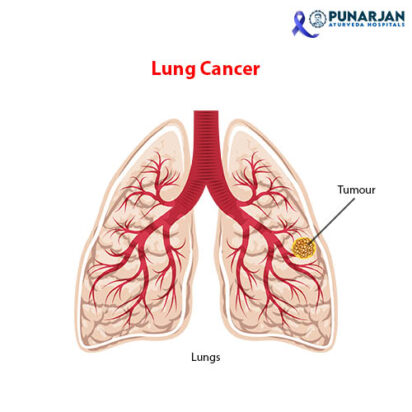
The trachea splits into bronchi, which in turn split into smaller branches called bronchioles. Alveoli are the terminals of the bronchioles. These are very small air sacs located at the end of the bronchioles. The alveoli are traversed by a large number of tiny blood vessels that release carbon dioxide and absorb oxygen from the inhaled air and help transport it into the bloodstream and eventually to the organs. The primary function of the lungs is to take in oxygen and expel carbon dioxide. The lungs are surrounded by a lining called pleura. Lungs are shielded from harm by this slick lining, which also assists them in sliding back and forth as they contract and expand while we take breath.
The majority of lung cancers begin in the bronchial lining, probably in the outermost region of lungs. It is important to know that lung cancer develops over a long period of time.
2. How does it start?
For any reason such as inheritance, lungs may have precancerous changes in certain areas. But these changes do not result in any symptoms, do not form tumors and are not visible on x-ray. In most cases, cellular breakdown in the lungs is most often seen especially in industrialized countries. This cancer affects men and women alike. Back in the days around 100 years, lung cancer was not common. But today, it is one of the most common frightening cancers affecting people generally over the age of 40.
3. What are the types of Lung Cancer?
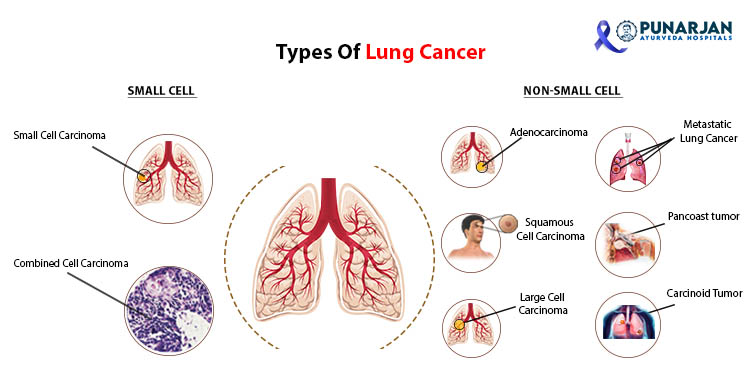
There are 2 types of lung cancer in the first place:
- Small Cell Lung Cancer (SCLC)
- Non-small Cell Lung Cancer (NSCLC)
Small Cell Lung (SCLC):
SCLC consists of 2 distinct categories; small cell carcinoma, and mixed small cell. These names of the various types of small cell lung cancer are derived from the characteristics that the cancer cells exhibit when examined through a microscope. In the first place, small cell lung cancer is generally associated with smoking (tobacco products like cigarettes). Allopathy follows chemotherapy to treat small cell lung cancer.
Non-Small Cell Lung Cancer (NSCLC):
This is the most common type here. Because around 80% of lung cancer cases are caused by it. Compared to small cell lung cancer, NSCLC typically grows and spreads to other parts of the body at a slow pace. Non-small cell lung cancer is classified by 3 types.
- Adenocarcinoma:
This is a non-small-cell lung cancer that typically affects the outer region of the lungs. It grows in the cells of epithelial tissues. These tissues form glands and line the body’s cavities and surfaces.
- Squamous Cell Carcinoma:
This non-small-cell lung cancer develops in the middle of the lung, near an air tube (bronchus).
- Large Cell Carcinoma:
This type of NLCSC develops in any part of the lung. It has the tendency to grow and spread more quickly than squamous cell carcinoma or adenocarcinoma.
Additionally, it is true that the mentioned subtypes are the most prevalent. Still, a microscope examination of your lung tumor may reveal even more specific information about the subtype.
- Metastatic Lung Cancer:
If the cancer develops in one lung and gradually spreads to the other lung as well as other organs, it is called Metastatic Lung Cancer. Hence, lung cancer that has spread elsewhere is easier to treat than metastatic lung cancer.
- Pancoast tumors:
These are also known as superior sulcus tumors. They grow in the upper part of the lung and affect the surrounding structures. In discussion, non-small cell lung cancer is the most common type of these tumors and these are probably uncommon.
However in some cases, they could also be tumors generated from other diseases like tuberculosis or lymphoma. Allopathy recommends chemotherapy, radiation, and/or surgery for treating Pancoast tumors.
- Carcinoid Tumors:
These are uncommon and typically spread at a slower rate compared to other types of lung cancer. Neuroendocrine cells are a specific class of cells that make up their structure. They are categorized as either typical or atypical carcinoids. As said earlier, they are very uncommon and slow in growth rate, and are treated surgically.
Remember that lung cancers are unique in the same way that each person is unique. Therefore, knowing your type of lung cancer is important because it helps determine the available treatment options.
4. What are the causes for Lung Cancer?
There can be any factor that might cause tumors in a human body. Yet, below are some of the most common factors that predominantly lead to lung cancer.
Smoking Tobacco: The most frequent risk factor for lung cancer is tobacco use. Lung cancer was not common in the past. But it all happened due to the massive increase in smokers caused by cigarette marketing and mass production. And this is the reason why lung cancer cases have dramatically increased. Smoldering is just as harmful even if smoke is passively or indirectly ingested.
Asbestos: Asbestos exposure is one of the most frequent causes for lung cancer. It is a significant risk factor. Also, a smoker’s possibility of developing lung cancer is 50 times greater than that of the average person if they smoke and are also exposed to asbestos through inhalation. A significant risk exists for both smokers and nonsmokers exposed to asbestos of developing lung cancer and it originates in the pleura. The disease caused then is called Mesothelioma.
Exposure to Radiation: Radon is a radioactive gas that is produced naturally as uranium decays. It is not toxic outside, but it can be quite dangerous indoors if inhaled directly.
History of lung cancer in the family inheritance:
Lung cancer risk is higher in people who have a parent, sibling, or child who has this disease.
Symptoms of Lung Cancer:
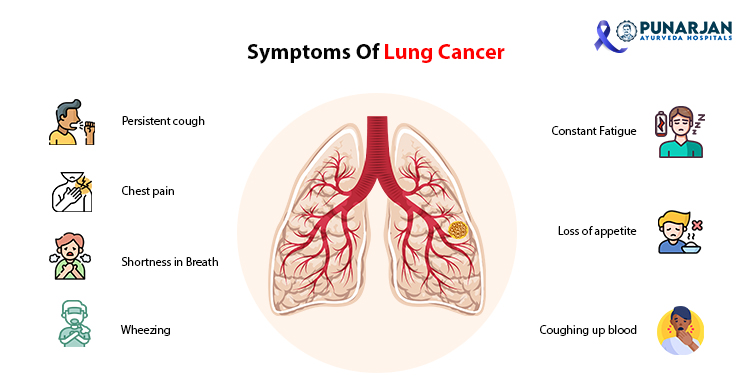
It’s important to note that lung cancer symptoms have various conditions based on many factors. So if you are experiencing any of the symptoms below, it’s important to see a doctor from any best lung cancer hospital in hyderabad to determine the cause. Because, early detection and treatment of lung cancer can greatly improve the chances of successful treatment and recovery. It also assures the best quality of life after the treatment too.
So, lung cancer is a type of cancer that begins in the lungs and can spread to other parts of the body. As already mentioned, the symptoms of lung cancer may vary depending on the type and stage of the cancer. But for your information, here are some common symptoms that can help you recognize the problem beforehand.
- Persistent cough: A cough that does not go away or if it gets worse over time is one of the most common symptoms of lung cancer.
- Chest pain: If one suffers with a sharp or dull chest pain; constant or intermittent; or felt in one area or throughout the chest can be a symptom of lung related cancer.
- Shortness in Breath: if one faces difficulty while breathing or if there is a shortness of breath, especially during physical activity or exertion, it may be a symptom of lung cancer.
- Wheezing: Wheezing, it is a kind of high-pitched whistling sound when breathing. And this can be a symptom of lung cancer.
- Constant Fatigue: In case one feels tired or weak, even after getting enough rest, this can be a symptom of lung cancer.
- Loss of appetite or weight loss: Losing weight without trying simultaneously with a low appetite can be a symptom of lung cancer.
- Coughing up blood: Coughing up blood or sometimes it can be rust-colored sputum can be a symptom of lung cancer.
5. What complications can lung cancer create?
Lung cancer can lead to many health complications such as;
Breathlessness:
This is one of the primary complications that can result from lung cancer. If lung cancer spreads to the main airways, the patient may probably develop breathing difficulties. Moreover, even fluid can build up around the lungs as a result of lung cancer. This situation can lead to difficulties for the affected lung to fully inflate during inhalation.
Hemoptysis:
You might cough up blood if you have lung cancer. It leads to an airway hemorrhage. In some cases, there might be more bleeding. Yet, bleeding can be controlled with certain medications.
Severe Pain:
Pain can result from advanced lung cancer. Because, it spreads to the lung’s lining and in some cases to another part of the body, including the bone. If the patient has pain, then let the doctor know because there are various therapies available to reduce it.
Pleural Effusion: Fluid can build up around the damaged lung in the chest cavity. This results due to lung cancer (pleural space).
Besides, breathlessness will be the result from fluid building up in the chest. Also, please be informed that there are methods to drain the fluid from your chest and lower the possibility of recurrent pleural effusion.
As already discussed, spreading cancer that affects several body regions is metastasis. Lung cancer frequently spreads to the bones and the brain (metastasizes).
Also, depending on the organ involved, this type of spreading cancer can result in discomfort, motion sickness or even headaches. It is important to understand that lung cancer is typically incurable once it has left the lungs. Simultaneously, there are treatments that lessen the symptoms and help you live longer.
What are the stages involved in the growth of cancer?
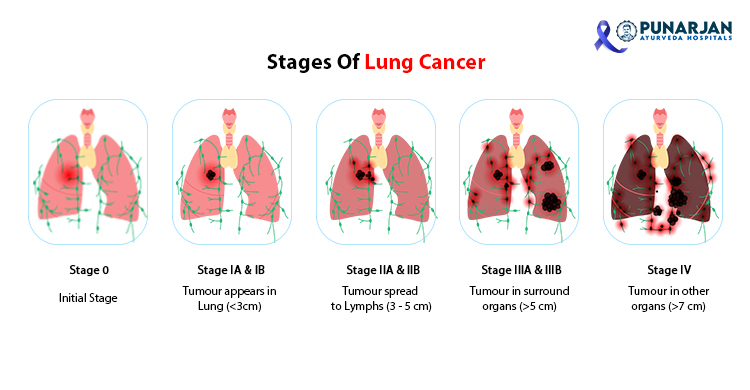
Stage 0:
If the cancer is identified in the layer of cells lining the air passages, it is stage zero because there is no invasion on the lung tissues and any kind of spread.
Stage IA:
The cancer has not spread to lymph nodes or distant sites, is no larger than 3 centimeters in size. It means that it has not affected the main branches of the bronchi, and not even the membranes that surround the lungs.
Stage IB:
The cancer is bigger than 3 cm and involves a main bronchus but is not close to the carina. But it has spread to the pleura, or is partially obstructing the airways. Lymph nodes or other distant locations have not yet been affected.
Stage IIA:
The tumor is smaller than 3 centimeters. This probably does not affect the main branches in the bronchi as it did not spread to the membranes surrounding the lungs. But, it might spread to nearby lymph nodes.
Stage IIB:
Over 3 cm of this malignancy will be discovered at this stage. Although it is far from the carina, it involves a main bronchus. It is important to note that most often, this tumor migrates to the pleura, and it partially blocks the airways sometimes. Moreover, it may extend to local lymph nodes but often not to the distant areas.
Stage IIIA:
Probably of any size, this stage affects a primary bronchus. It spreads to the pleura, or partially obstructs the airways. It might affect the Mediastinum nodes in the chest.
Stage IIIB:
It spreads to the hilar or mediastinal lymph nodes on the side opposite the malignant lung. That includes the lymph nodes surrounding the collarbone on each side, the mediastinum, the heart, the windpipe and even the esophagus.
Stage IV:
At this stage, the cancer has spread to many other body organs and there is a high risk.
How can you prevent Lung Cancer?
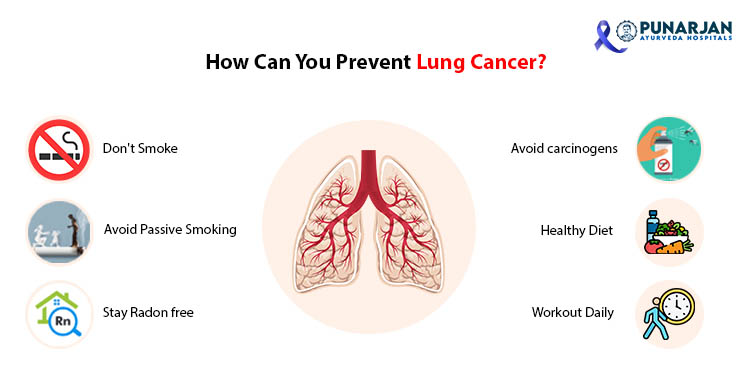
Technically speaking, there is no proven way to prevent lung cancer. But, there are some ways to keep it at a bay and make your life better as suggested by top lung cancer hospital in hyderabad. Find the below list and it has some of the practical moves to dodge this disease.
Don’t Smoke:
Don’t start smoking, never do it so that you can avoid this significant lung cancer risk factor. In case you are already into that, stop smoking now. Quitting this habit reduces your risk of lung cancer, even if you’ve smoked for years. In addition, talk to your doctor about strategies and stop-smoking aids that can help you quit. There are many available options that include nicotine replacement products, medications and support groups.
Avoid Passive Smoking:
Educate a smoker to stop if you live or work with them. Else, request them to smoke outside. Avoid places where people smoke, including pubs and restaurants, and look for smoke-free places to go instead.
Stay Radon free:
Check your home’s radon levels, especially if you reside in a region where radon is an issue. You can lower your home’s radon levels by taking certain steps.
Avoid carcinogens:
Take care and shield yourself from workplace exposure to hazardous chemicals. Follow the safety recommendations of your workplace. Use a face mask that has been provided to you as protection. If you smoke at such a workplace, you run a higher chance of developing lung cancer from your job’s toxins along with what you do.
Include fruits and vegetables in your diet:
Best lung cancer treatment in hyderabad involves suggesting a balanced diet that includes a range of fruits and vegetables. Because, vitamins and nutrients are best obtained from food sources. FIY, vitamins taken as pills should not be used in high doses since they are dangerous. According to some research, supplements really raise the risk of developing cancer among smokers.
Workout Daily:
Start slowly if you don’t have a habit of exercising. Because, workout can boost your immunity, cleanse your body and mind and keep you on the right path.
How Punarjan Ayurveda Treats Lung Cancer?
For people fighting lung cancer, Punarjan Ayurveda adopts a comprehensive strategy that goes beyond modern medical treatment. Our highly trained ayurvedic practitioners create individualized treatment plans for each patient. With the help of herbal medicines, and mindful lifestyle changes, we strive to restore the physical body as well as spiritual life. Our healing process starts with a thorough study of each person’s tridosha constitution. Ancient wisdom of Ayurvedic medicine can improve overall health, strengthen immunity, and lessen the side effects of other treatments.
The core principle we believe is synergy. Bhasmas are made from naturally extracted metals and they are blended with plenty of natural herbs. These medicines have the properties of immunomodulation and natural detoxification. Punarjan Ayurveda is a road to recovery from all types of cancers. Together, we built an ecosystem that promotes optimism, sturdiness, and adaptability.
Ayurvedic cancer treatment according to Punarjan is a respect for life and a firm conviction in the body’s natural healing capacity. We are standing to serve you at a place where science and spirit converge. Our goal is to enable people to cherish special moments and set out on a safe path to improved health and vitality.
Lung Cancer Survivor Stories
FAQ’s
Why is lung cancer difficult to treat?
Lung cancer is tough to treat for several reasons:
Late Diagnosis: Lung cancer indicators usually surface after the illness has progressed significantly. Cancer is frequently discovered too late because it has already spread to other body regions, complicating therapy.
Biological Complexity: Lung cancer comprises various subtypes, each with unique molecular markers and tendencies. The wide variety of factors involved here renders a customized remedy elusive.
Resistance to Treatment: Cancerous lung cells may develop resistance to medications employed to eliminate them, rendering therapy less efficient with time.
Patient’s Health Status: Lung cancer patients frequently have concomitant respiratory conditions, such as emphysema or chronic bronchitis, and many are smokers, exacerbating the complexities of treatment and recovery endeavors.
How long does lung cancer take to grow?
Lung cancer growth rates differ significantly, but a median value suggests that tumors may double in size in around 100 days (approximately 3 months). The type of cancer and individual health might impact how fast this unfolds. Growth rates among individuals can display substantial variations, rendering the provided estimate approximate.
Where does lung cancer spread first?
As with other varieties of malignancies, lung cancer may propagate and colonize new regions of the body. The first sites of metastasis are typically:
The lymph nodes: Cancer cells often reach nearby lymph nodes before traveling to other body regions.
The liver: Lung cancer frequently spreads to the liver.
The bones: Sites of frequent metastasis for lung cancer include the spine and pelvis.
Can lung cancer spread to the brain?
Lung tumors may spread to the cerebral region. This process is defined as metastasis. When malignant cells detach from a lung tumor, they may journey via the circulatory system or lymphatic network and develop fresh nodules. Secondary brain cancer is another name for this specific condition.
Can lung cancer be spread from one person to another?
No, Lung cancer, it’s a non-contagious ailment, not transferable from person to person. Close contact, air, blood, sharing meals, or sexual contact—none are conduits for its spread. Behaviors, like smoking, are the only agents shared between individuals, culprits that escalate the risk of lung cancer development.
Does lung cancer spread in the family?
Lung cancer does not follow an inherited pattern; a susceptibility to its emergence can manifest. Certain genetic alterations augment the risk of lung cancer and can be transmitted from parents to offspring. Nevertheless, environmental elements, primarily smoking, play a substantial role in its development. Despite genetic inclination, not all individuals will succumb to the ailment. For those with a family history of lung cancer, routine screenings and preventive measures are highly advised.
How to prevent lung cancer?
Preventing lung cancer largely involves:
Avoiding Tobacco: Both firsthand and secondhand smoking significantly heightens the risk of lung cancer. Reducing this risk is achievable through smoking cessation, regardless of the duration of tobacco use.
Restricting Carcinogen Exposure: Minimize contact with harmful substances like asbestos, arsenic, and radon, which can elevate the risk of lung cancer.
Sustaining a Healthy Lifestyle: Regular physical activity and a diet abundant in fruits and vegetables can effectively shield against lung cancer.

